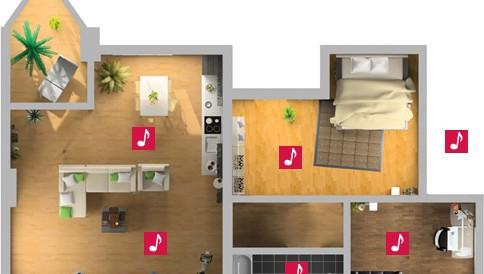Thank you so much for sharing this beautiful and useful article. I am very much interested in music and I am working in a Professional resume writing service. How make music feel good? It depends on the quality of the sound produced by our audio system. The best system in the world is only as good as how it is set up. The excitement most of us feel opening up those boxes containing our new system components often turns to despair as we anticipate the task of assembly. There are a few things you can do to get your home theater up and running sooner and better than you thought was possible. Installation is as much art as it is science. Remember that it's you that paid for your home theater and it's you and your family that has to enjoy it.
Tips for Planning for Your Wholehouse Audio Install

This time, I’m tackling things to consider when adding an audio system. Many people think audio is a simple install now because there are so many wireless options available, but wireless refers to transmitting and receiving the audio signal, and systems still require wiring from the amplifier to the speakers. And while wireless systems like Sonos and PlayFi are great problem solvers, they might not be the ideal solution for everyone.
When it comes to filling your home with great sound—or any sound, for that matter—you want to focus on these four things: location, control, zones, and TV audio. Let’s look at each.
Location
Depending on how many rooms you’re adding music to, the install will likely require a decent stack of gear and a fair amount of speaker wire. Because of this, the equipment location needs to take into account ventilation, wire management, and future accessibility/serviceability. With a wireless or network-based audio system, you could
decentralize the gear, say, locating amplifiers in various rooms around the house or a top shelf in a closet. This method shortens speaker runs and eliminates the need for a rack of equipment. The more traditional method is to “homerun” all of the wiring to a central location. This centralized approach is nice because it makes upgrading easier down the road since everything is all in one spot.
Many people think audio is a simple install because of wireless options but systems still require wiring from the amplifier to speakers.
ControlLikely the only audio equipment in any given room will be the speakers, so how users interact with the system is crucial. While most modern systems offer terrific smartphone and tablet control, the main drawback with these app-based control systems is that guests are unable to use them. Even if you installed the app for them—and allowed them to log onto your network and connect to your system—they probably couldn’t figure it out. If this isn’t a concern, then by all means go with an app-based control system. My company often installs good old, tried-and-true volume controls in guest rooms for easy level adjustment of the music the homeowner selects. In-wall keypads or touchscreen-based systems are another option. The advantage is these devices are always on, never leave the room, and can provide simple, one-touch access to music.
Zones
In housewide audio parlance, a zone is an area that can play something different from another, and a zone could consist of one room or 100. The more zones you have, the more flexible (and likely expensive) the system will be. Many audio distribution systems come in a six-source/six-zone chassis, with inputs and amplification to drive six
rooms. However, if you don’t need the flexibility of six different things playing at once, a simple one-, two-, or three-zone system might be perfect. In fact, just using the Zone 2 output on many AV receivers is often enough to satisfy the music needs of smaller households. By connecting your source to a powerful amplifier and speaker selector/protector, or by using a multichannel amplifier, you can add volume controls in each room to provide a simple and low-cost way to tailor the volume in each sub-zone listening space.
TV Audio
Many people assume the TV’s audio will come out of the housewide speakers, and it can, but it takes some planning and hardware to work. Televisions can’t drive an external pair of speakers, so there are a couple of solutions. Option one is running the TV’s audio signal back to the house audio amplifier and just making it another source. Option two requires a device like Sonance’s SonAmp ASAP3D SE. This is an automated A/B speaker switcher with an internal amplifier. When the TV is off, the speakers play the
housewide music; when the TV turns on, they automatically start playing the TV sound. Simple, cool, and a terrific solution.
- Log in or register to post comments


Your breakdown of location considerations for audio gear and the pros/cons of centralized versus decentralized setups is enlightening. The discussion on zones and the flexibility they offer in audio distribution systems adds a valuable layer of understanding.
Best Mortgage Broker in West Sacramento CA






























































